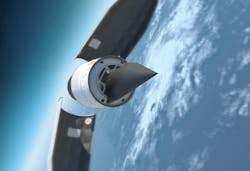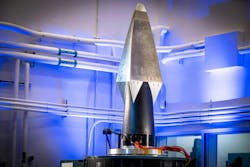Hypersonic research progressing toward possible future weapons and aircraft deployment
U.S. hypersonic weapons and aircraft development has progressed over the past year, bringing several trends into focus, and helping to chart a future for future weapons and planes that can travel at speeds of at least five times the speed of sound -- or nearly 4,000 miles per hour.
Such capability could deliver guided munitions able to attack an adversary virtually before he could activate air defenses. It could help deliver an aircraft able to fly coast-to-coast in less than an hour. It could provide weapons that might not need explosives at all, but instead rely on the destructive force of their high kinetic energy alone.
Several research programs are planned, in progress, or completed to develop enabling technologies for hypersonic projects, and top U.S. Department of Defense (DOD) leaders have identified hypersonics as one of the Pentagon's top priorities, which has the potential to create deployable hypersonic systems within the next decade. It all depends on whether these kinds of technologies retain their priorities at the top of the military's list.
Stages of development
The Pentagon's 2025 budget request for hypersonic research was $6.9 billion -- up from $4.7 billion in the 2023 request. Despite this funding increase, the Pentagon still has not established any programs of record for hypersonic weapons, according to the report Hypersonic Weapons: Background and Issues for Congress, submitted by the U.S. Congressional Research Service in February.
This suggests that Pentagon leaders have approved neither solid mission requirements or long-term funding plans, the report states. In fact, DOD has not yet made a decision to buy hypersonic weapons and instead is only going as far as developing research prototypes. Today it's unclear when, or even if, the DOD will move hypersonics out of solely research projects and into well-defined procurement programs, despite spending billions on these technologies.
Hypersonic weapons development still is in its early stages, and it's an open question how urgent it is for U.S. military researchers and systems designers to develop these kinds of weapons quickly. It's plain, though, according to the Congressional Research Service, that the United States does not have systems that can hold adversaries like China and Russia at risk of hypersonic missile attacks, and that the U.S. military does not yet have defenses against adversary hypersonic weapons. Furthermore, the Congressional Research Service says, U.S. defense officials believe that today's terrestrial and space-based sensor architectures are insufficient to detect and track adversarial hypersonic weapons.
Current hypersonic research
The Pentagon has four primary hypersonics research programs in progress: the Navy Conventional Prompt Strike (CPS) and Offensive Anti-Surface Warfare Increment 2 (OASuW Inc 2), also known as Hypersonic Air-Launched OASuW (HALO); the Army Long-Range Hypersonic Weapon (LRHW); and the Air Force Hypersonic Attack Cruise Missile (HACM) projects. There may be more hypersonic research being conducted at the classified level.
Perhaps the DOD's most high-profile hypersonics research project is the Navy Conventional Prompt Strike (CPS), which is a hypersonic boost-glide missile development and test program that provides long range, short flight times, and high survivability against enemy defenses.
The Navy and Army are collaborating on hypersonic development that involves paring a Common Hypersonic Glide Body with a booster system to create a common hypersonic all-up round (AUR) for use by the Navy and Army. The first test of the AUR in June 2022 was failure, but tests last December succeeded.
Last February the Navy Strategic Systems Programs office in Washington announced an $86.7 million contract to the Lockheed Martin Space segment in Littleton, Colo., for Advanced Payload Modules (APMs) for the Navy's three Zumwalt-class destroyers. The APM is to enable the Zumwalt-class destroyer to fire the hypersonic Lockheed Martin CPS hypersonic missile in packages of three. Each APM will hold three Conventional Prompt Strike hypersonic missiles, for a total of 12 missiles aimed at a variety of high-priority and time-critical targets.
Conventional Prompt Strike (CPS)
Lockheed Martin's CPS is a boost-glide hypersonic missile with a two stage solid rocket motor, a hypersonic glide body, and kinetic-energy warhead. DOD leaders say they eventually plan to launch CPS from Zumwalt-class destroyers and Virginia-class attack submarines to strike valuable mobile targets. First deployment of the CPS is scheduled for as early as 2028 aboard Virginia-class attack submarines.
While the Advanced Payload Module is a hypersonic missile launcher for Zumwalt-class destroyers, the so-called Virginia Payload Module is the hypersonic missile launcher for Virginia-class attack submarines.
The three Zumwalt-class destroyers -- USS Zumwalt (DDG 1000), USS Michael Monsoor (DDG 1001), and USS Lyndon B. Johnson (DDG 1002) -- are multi-mission stealth ships with onboard computers and computer networking that focus on land attack, with secondary roles of surface warfare, anti-aircraft warfare, and naval gunfire support.
The Zumwalt-class destroyer has a specially shaped hull and superstructure that scatters radar signals and gives the ship a much smaller radar cross section that it otherwise would have with a conventional design.
Last November Leidos Dynetics Technical Solutions (DTS) in Huntsville, Ala., won a $670.5 million U.S. Army contract to build the common hypersonic glide body and thermal protection system. DTS is a wholly owned subsidiary of Leidos Dynetics. DTS is working with Lockheed Martin Corp. to support integration and prototyping of the new common hypersonic glide body.
The Army is asking DTS to produce the first commercially manufactured set of common hypersonic glide body systems for prototyping the new common hypersonic glide body, which is expected to be available across military services to provide commonality to air-, land-, and sea-launched hypersonic weapons.
The common hypersonic glide body is being developed by the U.S. Navy and Army to travel at hypersonic speeds and glide towards its target. A booster rocket accelerates the common hypersonic glide body to hypersonic speeds, then releases it to glide on its own. Lockheed Martin also is working with the Army on multi-year hypersonic weapons development in support of the Army's focus on long-range precision-strike missiles.
Last June Lockheed Martin won a $534 million order for systems engineering and testing for CPS hypersonic missiles. Last July the Navy awarded a $22.9 million order to General Dynamics Bath Iron Works in Bath, Maine, to start building the Large Missile Vertical Launch System (LMVLS) launch module fabrication for the USS Michael Monsoor (DDG 1001) The LMVLS launcher will enable the three Zumwalt-class destroyers to launch the future CPS hypersonic missile.
LMVLS launchers are to replace or augment the Advanced Gun Systems (AGS) aboard the Zumwalt, Monsoor, and Johnson. The LMVLS launchers will shoot the CPS missile with a two stage solid rocket motor, a hypersonic glide body, and kinetic-energy warhead. A hypersonic projectile travels at speeds of at least five times the speed of sound, or about 3,800 miles per hour.
HALO project
The Navy's future Hypersonic Air-Launched Offensive Anti-Surface Warfare Weapon System project -- collectively known as HALO -- has been quiet over the past year. This development project is to enable carrier-based aircraft to conduct stand-off strikes against high-value surface threats. It penetrates near-peer air-defense systems to defeat high-value surface threats, so the Navy can operate in and control contested battles spaces.
The Navy has announced plans to approach industry to develop the HALO hypersonic munition that can be launched from carrier-based aircraft for attacking enemy surface ships and shore installations. If successful, this weapon may replace or augment a variety of today's anti-ship missiles.
Preliminary development of HALO has been handled by Lockheed Martin and by the RTX Corp. Raytheon segment in Tucson, Ariz. HALO likely will augment or replace or anti-ship missile systems like the Long Range Anti-Ship Missile (LRASM), Harpoon, and Penguin missiles. Hypersonic missiles typically will be for attacking high-value targets like enemy capital ships, command posts, or forward-staging areas.
The HALO hypersonic weapon should have early fielding by 2029, and first operational capability by 2031. Only eligible prime contractors who have experience with carrier-based hypersonic weapons development -- like Raytheon and Lockheed Martin -- will have access to the upcoming HALO solicitations.
LRHW project
The Army's Long Range Hypersonic Weapon (LRHW) is to use a common hypersonic all up round. This project also will capitalize on the common hypersonic boost glide all up round and, in partnership with the Navy's CPS program, introduce a new class of ultrafast and maneuverable long-range missiles with the ability to launch from ground-mobile platforms.
Last May the Army awarded Lockheed Martin a $756.8 million order to provide LRHW ground support equipment. Lockheed Martin is prime contractor for LRHW systems integration. The Lockheed Martin-team is developing a land-based hypersonic strike missile prototype in partnership with the Army Hypersonic Project Office.
The Lockheed Martin LRHW team includes Leidos Dynetics Technical Solutions (DTS) in Huntsville, Ala.; Integration Innovation Inc. (i3) in Huntsville, Ala.; Verity Integrated Systems in Huntsville, Ala.; Martinez & Turek Inc. in Rialto, Calif.; and Penta Research Inc. in Huntsville, Ala.
The LRHW prototype will capitalize on the DTS Common-Hypersonic Glide Body (C-HGB) prototypes, and introduce a new class of ultrafast and maneuverable long-range missiles with the ability to fire from mobile ground launchers. Hypersonic munitions travel at speeds at least as fast as Mach 5, or five times the speed of sound.
Hypersonic strike weapons are a key aspect of the Army's Long Range Precision Fires (LRPF) effort to develop long-range artillery-delivered munitions able to fire as far as 187 miles, as well as the national security strategy to compete with and outpace potential enemies in hypersonics.
HACM program
The U.S. Air Force Hypersonic Attack Cruise Missile (HACM) program seeks to create a scramjet-powered hypersonic missile as an operational weapon. HACM contractors include RTX Raytheon and Northrop Grumman Corp. Future HACM munitions will go aboard aircraft such as the Boeing F-15EX and F-15E Strike Eagle jet fighter bombers.
RTX Raytheon and Northrop Grumman are working under terms of a $985.3 million order announced in September 2022 to develop HACM, which is to be one of the first hypersonic cruise missiles to be in the U.S. inventory. Last fall the Air Force awarded RTX Raytheon a $73 million contract to enhance the company's manufacturing capacity to produce HACM.
Last June the U.S. Government Accountability Office, the investigative arm of Congress, reported that Air Force leaders expect to fly 13 HACM tests between October 2024 and March 2027. A production decision may come after 2027 testing if all goes well. HACM may undergo a critical design review as early as this year, and has the potential to move to a military program of record as early as 2027.
The HACM project incorporates enabling technologies from other research projects. In 2020, the Air Force joined Australia in a multi-year project called the Southern Cross Integrated Flight Research Experiment (SCIFiRE) to develop air-breathing hypersonic cruise missile prototypes. The Air Force awarded three 15-month SCIFiRE contracts in June 2021 to Boeing Co., Lockheed Martin Corp., and RTX Raytheon to complete preliminary designs of a hypersonic cruise missile.
The HACM program will bring the RTX Raytheon SCIFiRE prototype design into production for fighter aircraft integration, and deliver two leave-behind assets with operational utility. Through SCIFiRE, the U.S. and Australia will continue collaborating on HACM design and development, including using Australian test sites for the initial all-up-round flight tests.
Hypervelocity projectiles
While not technically part of military hypersonic programs, the U.S. Army is working on so-called "hypervelocity" projectiles that will be designed to fly through the air at speeds of 8 or 9 times the speed of sound. The Army issued a request for information last summer for the Hypervelocity Projectile (HVP) program.
Officials of the Army Rapid Capabilities and Critical Technologies Office (RCCTO) at Fort Belvoir, Va., are looking for companies able to deliver HVP prototypes no later than fall 2027 for operational demonstrations in 2028, and later for possible deployment.
The HVP for air defense applications seeks to reduce munition costs and enhance the value of wheeled 155-millimeter artillery systems firing HVPs. The HVP prototypes will communicate with off-board sensors that track the HVP and the threat to be intercepted. BAE Systems has developed a hypervelocity projectile for potential naval use.
The HVP prototypes should fire from rifled and smooth-bore 155-millimeter cannons; interface with Army-provided off-board sensors to intercept the incoming threat; interface with a data transmission device to receive pre-launch mission data; maintain projectile maneuverability through interception; keep flight time to a minimum; and be powerful enough to shoot down fixed-wing aircraft, helicopters, UAVs, and cruise missiles. Army officials also are interested in rapid ammunition resupply, as well as supportability, safety, and cyber security.
In a related hypervelocity munitions development, the Army issued a request for information last December for the Multi-Function Precision Radar (MFPR) project, which seeks to find companies able to build four prototype surveillance radar systems by fall 2027 that are able to guide Army hypervelocity weapons to their targets.
Multi-function precision radars should perform not only search, detection, and precision tracking of incoming threats, but also provide Army hypervelocity projectiles with the ability via datalink to navigate, fuze accurately, and possibly even provide battle damage assessment.
The multi-function radar would provide accurate and low-latency detection of hostile threats and help guide future Multi-Domain Artillery Cannon System (MDACS) projectiles at long ranges and in bad weather conditions like heavy rain, snow, wind, and dust. MDACS is to be new development program next year for air and missile defense against cruise missiles and unmanned aircraft.
The MFPR is to track the cannon-fired Hypervelocity Projectile, as well as incoming threats, and help guide the munition to incoming threats using external government-furnished Command and Control Battle Manager (C2BM) and the Integrated Air and Missile Defense (IAMD) Battle Command System (IBCS).
The MFPR must be accurate enough to help the hypervelocity projectile intercept incoming threats. What's significant is the hypervelocity projectile does not have an onboard seeker. Developing this kind of multi-function precision radar technology has the potential to help drive down the costs of air- and missile-defense munitions by enabling these weapons to operate without expensive onboard seekers and guidance systems.
The MFPR Prototypes should perform in an operational band that is available or could be available for military use worldwide; provide precision radar track data to support projectiles in flight via a communications link; provide long-range high-precision angular coverage for search detection; be able to detect threats and friendly projectiles; operable in high-clutter environments; interface with government-furnished command and control; and demonstrate supportability, safety, and cyber security.
Hypersonic aircraft research
Last fall Venus Aerospace in Houston introduced the VDR2 propulsion system to power high-speed vehicles such as drones and aircraft. The engine is engineered for long-range travel at high altitudes and can reach speeds as fast as Mach 6.
The VDR2 integrates two technologies: the Rotating Detonation Rocket Engine (RDRE), which provides high thrust, and a ramjet, which ensures efficient cruising. This combination enables the engine to operate from takeoff through hypersonic speeds without complex mechanical systems. Venus Aerospace officials say they will fly the VDR2 engine in hypersonic test drone sometime this year.
Venus plans to equip its RDRE on its commercial hypersonic aircraft, the Stargazer M400. Venus officials say the aircraft will cruise at Mach 4 at altitudes to 110,000 feet with a top speed of Mach 9.
The plane is expected to take off from conventional runways using advanced propulsion systems, reach the edge of space, and cruise at extremely high altitudes before landing. Stargazer seeks to transform high-speed commercial and military travel with reusable technology.
Last summer GE Aerospace in Cincinnati demonstrated a hypersonic dual-mode ramjet that could enable high-speed flight and long range air travel. The dual-mode ramjet began testing last March at the GE Aerospace clean air continuous flow high-speed propulsion testing facility in Evendale, Ohio. The dual-mode ramjet demonstration showed a threefold increase in airflow over previously flight-tested hypersonic technology demonstrators.
Other developments in hypersonics
Lockheed Martin was involved in the U.S. Air Force's Air-launched Rapid Response Weapon (ARRW), which sought to combine critical high-speed flight technologies and accelerate the conversion of air-to-ground hypersonic strike capabilities to actual weapons. The hypersonic weapon was designed to travel at 3,800 miles per hour.
The AGM-183 ARRW was to capitalize on Tactical Boost Glide (TBG) technology developed under supervision of the U.S. Defense Advanced Research Projects Agency (DARPA) in Arlington, Va. The air-launched hypersonic glide vehicle prototype completed a test flight in June 2019, but then had three successive failures before completing three flight tests in 2022. The Air Force conducted its final test of ARRW in March 2024, before emphasis shifted to HACM. The Air Force did not request money for ARRW in 2025 and budget documents say the program as completed.
The U.S. National Aeronautics and Space Administration (NASA) Glenn Research Center in Cleveland has awarded contracts collectively worth $5.1 million to The Boeing Co. and Northrop Grumman Corp. for the High-Speed Endoatmospheric Commercial Vehicle Conceptual Design Study and Technology Roadmaps Development project.
NASA is seeking to develop enabling technologies for high-speed commercial transports able to fly at speeds between Mach 2 and Mach 5 that could enter service as early as the 2030s. Mach 3 to Mach 5 represent speeds between 1,535 and 3,836 miles per hour.
These studies were to identify key technology needs and opportunities to enable high-speed commercial passenger aircraft. NASA’s Hypersonic Technology and Commercial Supersonic Technology projects fall under the NASA Advanced Air Vehicles Program, which will lead efforts to develop an environmentally sustainable civilian high-speed aircraft.

John Keller | Editor-in-Chief
John Keller is the Editor-in-Chief, Military & Aerospace Electronics Magazine--provides extensive coverage and analysis of enabling electronics and optoelectronic technologies in military, space and commercial aviation applications. John has been a member of the Military & Aerospace Electronics staff since 1989 and chief editor since 1995.






